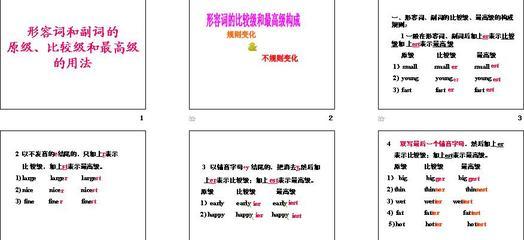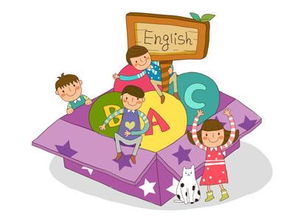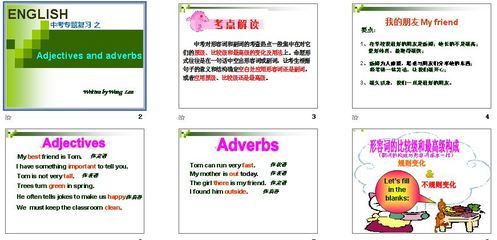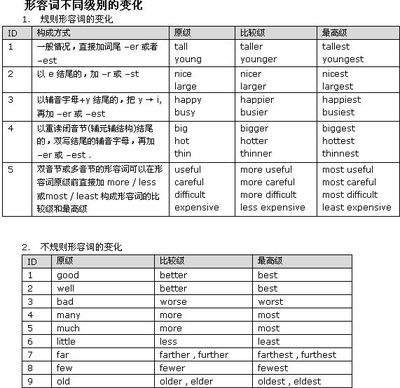在英语中组成句子的方式是将形容词或副词变化成比较级或最高级的形态,那么比较级或最高级是如何使用呢?以下是由爱华网小编整理关于比较级和最高级的用法的内容,希望大家喜欢!
比较级和最高级的用法一、形容词、副词的比较级和最高级的构成规则
1.一般单音节词和少数以-er,-ow结尾的双音节词,比较级在后面加-er,最高级在后面加-est;
(1)单音节词
如:small→smaller→smallest short→shorter→shortest
tall→taller→tallest great→greater→greatest
(2)双音节词
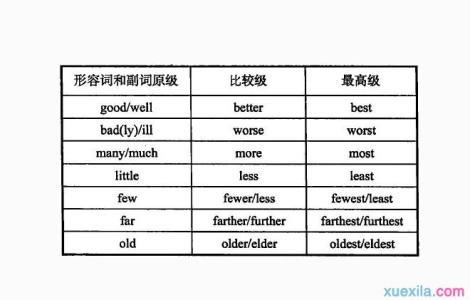
如:clever→cleverer→cleverest narrow→narrower→narrowest
2.以不发音e结尾的单音节词,比较在原级后加-r,最高级在原级后加-st;
如:large→larger→largest nice→nicer→nicest able→abler→ablest
3.在重读闭音节(即:辅音+元音+辅音)中,先双写末尾的辅音字母,比较级加-er,最高级加-est;
如:big→bigger→biggest hot→hotter→hottest fat→fatter→fattest
4.以“辅音字母+y”结尾的双音节词, 把y改为i,比较级加-er,最高级加-est;
如:easy→easier→easiest heavy→heavier→heaviest
busy→busier→busiest happy→happier→happiest
5.其他双音节词和多音节词,比较级在前面加more,最高级在前面加most;
如:beautiful→more beautiful→most beautiful
different→more different→most different
easily→more easily→most easily
注意:(1)形容词最高级前通常必须用定冠词 the,副词最高级前可不用.
例句: The Sahara is the biggest desert in the world.
(2) 形容词most前面没有the,不表示最高级的含义,只表示"非常".
It is a most important problem.
=It is a very important problem.
6.有少数形容词、副词的比较级和最高级是不规则的,必须熟记.
如:good→better→best well→better→best
bad→worse→worst ill→worse→worst
old→older/elder→oldest/eldest
many/much→more→most little→less→least
far →further/farther→ furthest/farthest
二、形容词、副词的比较级和最高级的用法
1.“A + be +形容词比较级 + than + B” 意思为“A比B更……”.
如:This tree is taller than that one. 这棵树比那棵树高.
注意:
① 在含有连词than的比较级中,前后的比较对象必须是同一范畴,即同类事物之间的比较.
②在比较级前面使用much,表示程度程度“强得多”.
如:A watermelon is much bigger than an apple.
③ very, quite一般只能修饰原级,不能修饰比较级.
2.“比较级 + and + 比较级”或“more and more +原级”表示“越来越……”
如:It becomes warmer and warmer when spring comes.
春天来了,天气变得越来越暖和了.
It is getting cooler and cooler.
天气越来越凉爽.
The wind became more and more heavily.
风变得越来越大.
Our school is becoming more and more beautiful.
我们的学校变得越来越美丽.
3.在含有or的选择疑问句中,如果有两者供选择,前面的形容词要用比较级形式.
如:Who is taller,Tim or Tom? 谁更高,Tim还是Tom?
4. “the +比较级……, the+比较级”,表示“越……越……”.
The more money you make, the more you spend.
钱你赚得越多,花得越多.
The sooner,the better.
越快越好.
 爱华网
爱华网